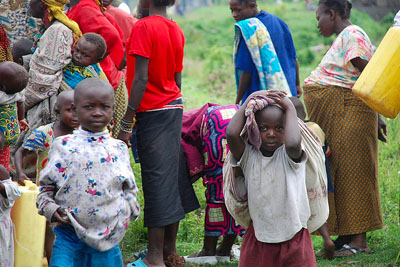
A recently released report by Human Rights Watch, or HRW, details the extent of suffering caused by displacement in eastern Congo in all of its stages. “Always on the Run: The Vicious Cycle of Displacement in Eastern Congo” examines the many causes of displacement, the trials internally displaced persons, or IDPs, face when seeking refuge, the abuses committed by armed actors against displaced populations, and the challenges IDPs face when – or if – they return home.
Dispelling the common view that IDPs stay in one camp until safely returning home, the report highlights the specific patterns of displacement found in eastern Congo. Many IDPs regularly return home or stay close to home and are consequentially forced to run not once, but twice, even more than three times from violence and insecurity. Some IDPs also move between different displacement sites or occupy new land, generating other forms of tension and challenges for aid agencies. These variations in displacement are important to note, the report says, as the strategies meant to protect IDPs must be flexible enough to recognize and react to these unique situations.
The report also summarizes official U.N. and government strategies aimed at protecting IDPs in eastern Congo, including a new Rapid Response to the Movement of Populations initiative, or RRMP, to add an emergency response component to existing policies, which allows aid to be focused on the most vulnerable IDPs. Set in motion by the Humanitarian Coordinator’s Office, UNICEF and OCHA run RRMP in eastern Congo, aiming to address the “flaws in the previous system that artificially categorized people into two main groups…and entirely ignored the needs of host communities looking after new and returning IDPs.” In its conclusion, the report calls for increased funding, necessary to better address the needs of the nearly two million IDPs in eastern Congo.
While HRW’s report focuses on eastern Congo, it is important to note that these findings apply to similar situations in Darfur and Chad as well. HRW’s analysis ties to the recent finding by the United Nations Human Rights Council, or UNHRC, that IDP children are hyper-vulnerable. The UNHRC report stresses the heightened insecurity children face in camps, where, in spite of management by the U.N., aid agencies, or the government, these places of refuge are now the foremost recruiting areas for child soldiers. Many children are sexually assaulted when attempting essential everyday tasks, such as going to the bathroom or collecting firewood. In excerpt from an interview with a young mother, the HRW report echoes these same trends for IDP children in eastern Congo:
My children were starving so I went with three women to a town close to our homes. Our village is too dangerous because of the FDLR. We tried to reach our fields, but as soon as we got near the FDLR saw us. Two of us escaped but they caught the other two and raped them. I came back here. Now we are starving again.
Hopefully, further in-depth analysis of the many sources of IDP insecurity and needs, as seen in these reports, will lead to more effective policies. The U.S. State Department noted yesterday that its top official on refugee issues, Assistant Secretary Eric Schwartz, met in New York with the head of U.N. peacekeeping, Alain Le Roy. The alarming findings of these two recent reports should have figured into their meeting as a top agenda item.

